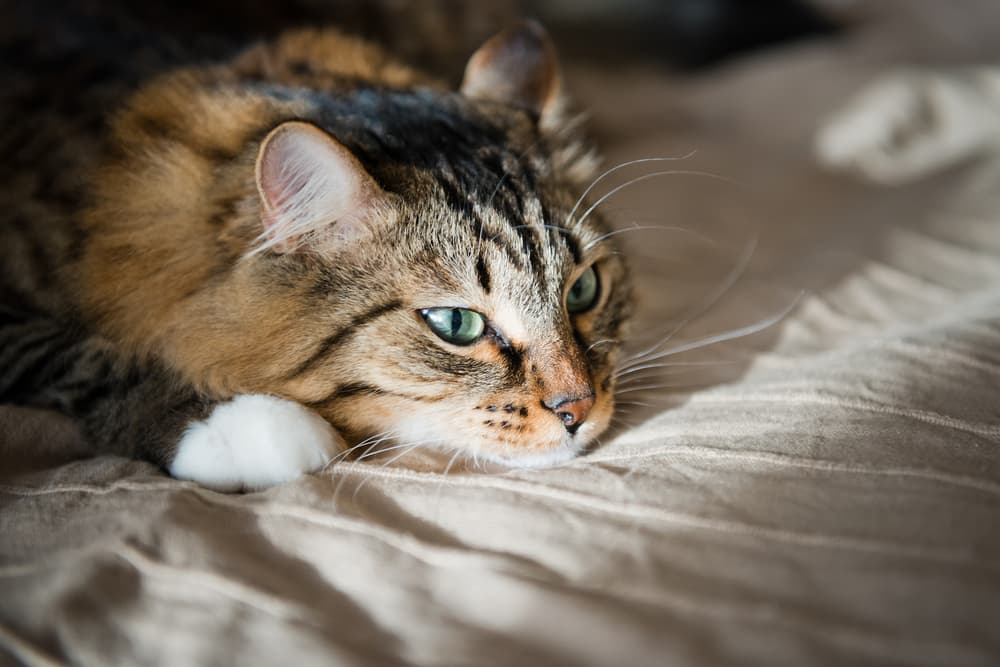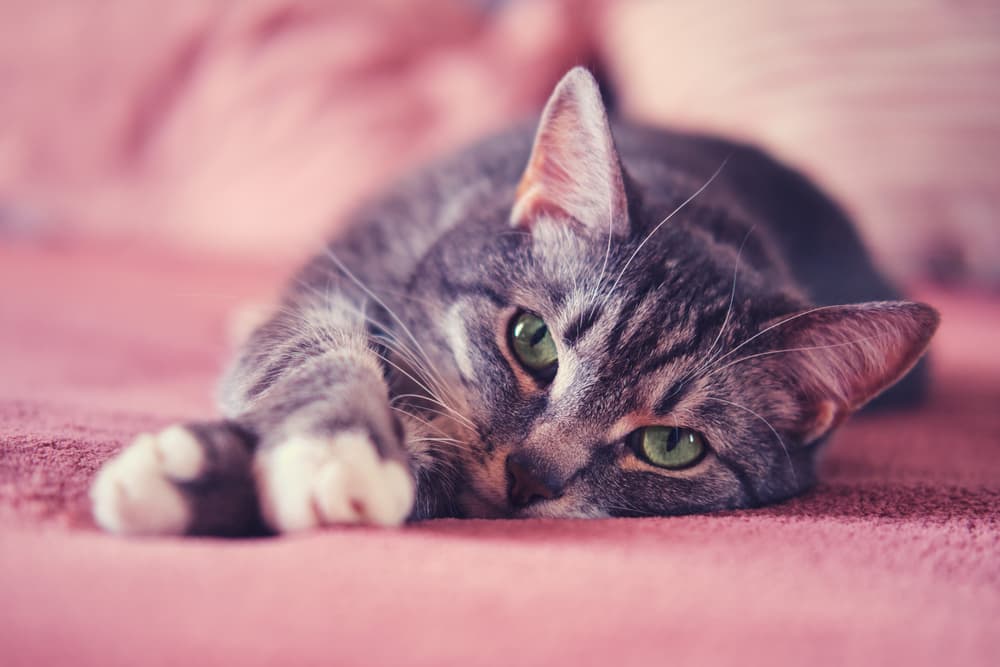How to Tell If a Cat Is in Pain: 8 Signs

Cats tend to play things pretty close to the vest. While this air of mystery is intriguing, it can also make it challenging to figure out how to tell if a cat is in pain. This is especially true when your cat isn’t feeling her best. In fact, cats make a point to hide when they are in pain.
“Cats are really interesting animals,” says Dr. Emily McCobb, clinical associate professor of anesthesiology at Cummings School of Veterinary Medicine at Tufts University. “While they are predators, they exhibit some prey animal behavior, like masking pain, because they don’t want to get eaten.”
So how can you tell if a cat is in pain and what should you do about it? There are signs to watch for that can help you determine next steps.
Do Cats Feel Pain?

Before we get into the signs that a cat is in pain, let’s clarify what sort of pain a cat feels. “Cats biologically have the same type of pain receptors that humans do in all parts of the body,” explains Emily Swiniarski, DVM, chief medical officer of PAWS Chicago in Chicago, Illinois. “It may not be the exact same experience as what a human has, but we know they feel pain in the same way that any other animal would when they have injury or ongoing medical issues.”
Cats can experience both acute and chronic pain. Acute pain is sudden, sharp, and often caused by an injury, illness, surgery, or medical procedure. It usually goes away when you resolve the cause of the pain. Chronic pain is the opposite. Chronic pain refers to ongoing discomfort and may not even be related to a past injury. Osteoarthritis (often referred to as arthritis) is one example condition that can cause chronic pain. Chronic pain is particularly hard to diagnose, as the signs of pain are very subtle.
Many signs of cat pain look like symptoms of other illnesses. But remember: Once you know how to tell if a cat is in pain, your job is to notice the signs and seek out help from a qualified veterinarian, not diagnose the condition.
8 Signs a Cat is in Pain

Ready to learn how to tell if a cat is in pain? Let’s explore some of the common signs and symptoms of pain in cats. A cat in pain may experience one or more of the following signs:
Changes in behavior
“A big sign that cats are in pain is a change in their activities,” explains Nancy Vail-Archer, DVM, medical director of NorthStar Vets Veterinary Emergency Trauma & Specialty Center in Maple Shade, New Jersey. “These changes can be subtle. For example, a cat that used to jump up on the counter all the time won’t anymore. Or the cat has reduced energy levels and less interest in play. What you’re looking for is the cat becoming less engaged in routine behaviors.”
Remember, it’s a CHANGE in behavior. A cat who has never shown interest in toys may just be lazy, not in pain.
Hiding
If your cat is normally sociable with people and then starts hiding rather than engaging with your family, it may signal pain and discomfort, Dr. Vail-Archer notes. It’s one of the most common changes pet parents report in their sick or painful cats. If your cat is usually under your feet in the morning as soon as you walk into the kitchen but now needs to be woken up after breakfast has been served, that could be a sign of pain as well. Again, this goes back to the first sign of any change in behavior being a possible sign of pain.
Not using the litter box
Peeing or pooping outside the litter box technically falls under “change in behavior” too. This change is another potential indicator something is off with your cat. They could be suffering from a painful health condition like a urinary tract infection (UTI) or even arthritis. Cats with joint pain due to arthritis may have trouble climbing in and out of the litter box. Or a cat with a UTI may strain to urinate and associate the litter box with pain so they find somewhere else to go.
Vocalizing

Some cats are more vocal than others. But if your normally quiet kitty starts meowing, crying, or moaning, especially when you touch a certain spot on their body or while they are using the litter box, take notice.
Limping/holding up a leg
Limping is one of the more obvious signs that a cat is in pain because you can see what body part is causing issues. Limping is ALWAYS a sign of pain. If a cat is favoring one leg over another, or won’t put a certain paw on the floor, that’s a clear signal that something is wrong.
Abnormal posture
Dr. McCobb notes that a relaxed cat will have a stretched-out body posture. If a cat is more crouched or curled, it indicates that the cat is ill, uncomfortable, or in pain. For example, a cat with stomach pain may not stretch out fully. Or a cat may only lay down on one side of their body to avoid pressure on a painful limb.
Aggression
Cats who are in pain are more likely to be irritable and may even lash out at their humans. These aggressive tendencies may be preceded by subtle signs such as facial expression changes, hissing, and/or growling. If your cat is usually friendly and suddenly becomes aggressive, pain could be to blame. Cats may lash out at their housemates—other cats or dogs—instead of their people.
Loss of appetite
Refusing to eat is a general sign of pain in cats linked to several conditions, ranging from dental problems to urinary disorders to cancer. The key is paying attention to other behaviors your cat is exhibiting along with loss of appetite. For example, “if you notice food is falling out of their mouth or they want to eat but they can’t seem to eat, those are signs of dental pain,” Dr. McCobb explains. A cat who is painful when walking may visit the food bowl fewer times per day.
Next Steps When Your Cat Is in Pain

While pet parents should always be on the lookout for signs and signals their cat might be in pain, some situations are more urgent than others. “If there’s a very small behavior change, say, for example, a small change in appetite, but your cat is still eating, drinking, and using the litter box, I would suggest monitoring them for a week to see if things turn around and go back to normal,” Dr. Swiniarski says. “If they don’t, you’ve probably noticed something that’s indicative of a chronic issue or something that’s not going to go away on its own, and you should seek out your veterinarian.”
Of course, if your cat gets worse, you should see a veterinarian immediately. “If your cat stops eating, stops using the litter box, isn’t active at all, or is unable to get up, those are signs of an emergency and you should see a veterinarian right away,” Dr. Swiniarski says.
Pain is easier to diagnose when pet parents are tuned into their cat’s behaviors and keep a thorough medical history, Dr. Vail-Archer says. “History is so important because the owners are the ones who really know their cat’s behavior. They’re an incredibly important part of the health care team when it comes to recognizing pain,” she says. “Getting a good history helps us to hone in on what exactly is wrong.”
How to Manage Pain in Cats

So what do you do once you’ve figured out how to tell if a cat is in pain and your vet has diagnosed the problem? You treat it. “A lot of cat owners don’t realize that there are many ways that we can treat pain and make our cats feel more comfortable,” Dr. Vail-Archer says. “These treatment options include acupuncture, physical rehabilitation, laser therapy, massage therapy, and even weight loss.”
Dr. McCobb adds that there pain medications and other pharmaceutical options for pain relief in cats as well. “We didn’t have a ton of great options for pain management in cats, especially when it comes to chronic pain, until very recently,” she says. “There’s a bunch of newer medications and treatment modalities that are safe for cats long term and can help us improve their quality of life as they’re living into their late teens.”
However, it’s important to consult with your veterinarian to ensure your cat’s pain medication is both safe and effective. For example, non-steroidal anti-inflammatory drugs (NSAIDs) like meloxicam may help relieve moderate pain in cats. However, it’s largely used as a short-term pain remedy since long-term use has been linked to feline renal failure.
Luckily, there are other types of cat pain medication that can provide relief. Steroids like the anti-inflammatory drug prednisolone can ease feline arthritis pain due to inflammation. Gababentin is often used to relieve chronic nerve, muscle, or bone pain in cats.



In some cases, your vet may recommend a nutritional supplement as part of your cat’s pain treatment plan. For example, cats with arthritis pain may benefit from supplements fortified with chondroitin and glucosamine to help support joint health and relieve arthritis pain.



Different sources of pain require different treatments. So it’s best to work with your veterinarian to develop a customized pain management plan. If you have questions about how to relieve your cat’s pain, call your veterinarian to talk about treatment options.









